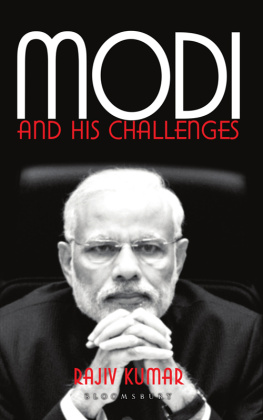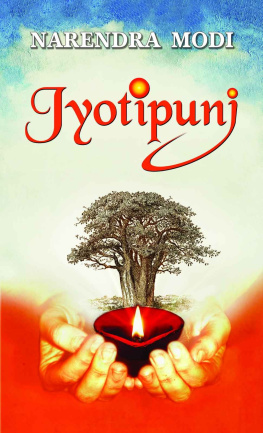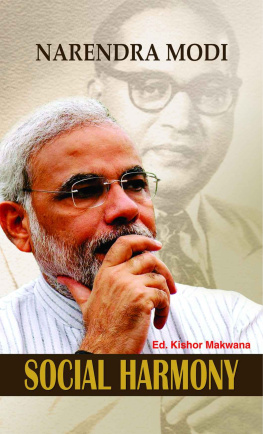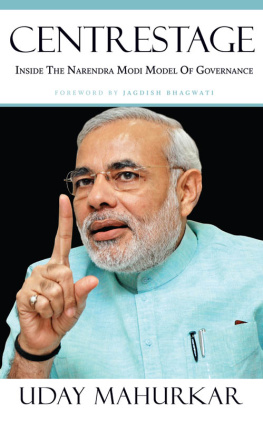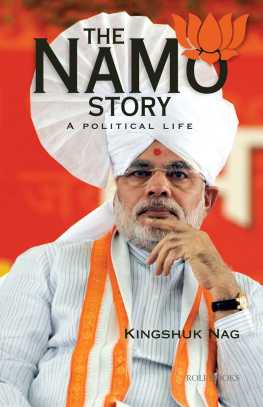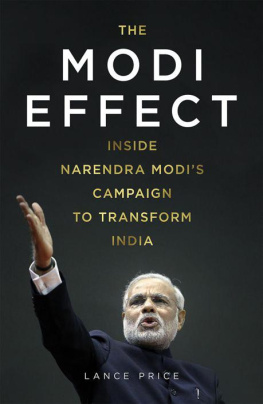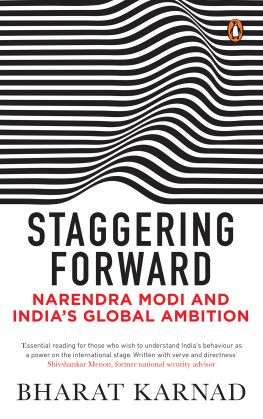Contents
Guide

Modi and His Challenges
Rajiv Kumar

First published in India 2016
2016 by Rajiv Kumar
All rights reserved. No part of this publication may be reproduced or transmitted in any form or by any means, electronic or mechanical, including photocopying, recording, or any information storage or retrieval system, without prior permission in writing from the publishers.
No responsibility for loss caused to any individual or organization acting on or refraining from action as a result of the material in this publication can be accepted by Bloomsbury or the author.
The content of this book is the sole expression and opinion of its author, and not of the publisher. The publisher in no manner is liable for any opinion or views expressed by the author. While best efforts have been made in preparing this book, the publisher makes no representations or warranties of any kind and assumes no liabilities of any kind with respect to the accuracy or completeness of the content and specifically disclaims any implied warranties of merchantability or fitness of use for a particular purpose.
The publisher believes that the content of this book does not violate any existing copyright/intellectual property of others in any manner whatsoever. However, in case any source has not been duly attributed, the publisher may be notified in writing for necessary action.
BLOOMSBURY and the Diana logo are trademarks of Bloomsbury Publishing Plc
ISBN 978 93 84898 34 2
E-ISBN 978 93 85936 32 6
2 4 6 8 10 9 7 5 3 1
Bloomsbury Publishing India Pvt. Ltd
Second Floor, LSC Building No.4
DDA Complex, Pocket C 6 & 7, Vasant Kunj
New Delhi 110070
www.bloomsbury.com
Typeset by Manipal Digital Systems
Printed and bound in India by Thomson Press Pvt Ltd
To find out more about our authors and books visit www.bloomsbury.com.
Here you will find extracts, author interviews, details of forthcoming events and the option to sign up for our newsletters.
Dedicated to Divine Mother Shri Mataji Nirmala Devi"
CONTENTS
I took up the challenge to write this book principally because it would give me the reason to better understand a man who had managed to transfix my attention like those of millions of Indians for nearly two years and who defied being stereotyped. I had been following his career since my first meeting with him in Gandhinagar on 16th December 2011, which he may recall given his reputedly elephantine memory. This ninety-minute interaction had evoked very mixed feelings. I was impressed by the sharp focus on economic development during his speech to the gathered businessmen. His apparent informality at sharing the dining table and recounting his experiences set him apart from many other political leaders I have had the occasion to interact over the years. His multiple car cavalcade teeming with special forces in their black uniforms (because he had Z class security cover) and his authoritative strides towards them made me intuitively apprehensive. His openness to ideas, eye to detail and knowledge of frontline technology surprised me as this was in complete contrast with other politicians.
Although, I have met him on more than one occasion since, these first impressions have remained firmly imprinted on my mind. Surprisingly, I have carried a different impression from every subsequent meeting. Such is his quicksilver quality. It was, therefore almost inevitable for me to accept without a moments hesitation the opportunity to examine with an open mind, the strengths and weaknesses of the newly elected prime minister and his ability to seize the opportunities for taking India forward towards good times.
But my initial excitement quickly wore off as I began to discover that this was to be an inordinately difficult assignment for various reasons of which, three stand out. First, I found out from the very first conversation or interview that I had, that any opinion, whether positive or negative, that I had formed about the incumbent prime minister, was vehemently contested by those to whom I would express it. There were apparently an entire range of impressions, opinions and perceptions, both within the political circles and outside it and in Ahmedabad and Delhi, which I had to contend with. I was confronted with a most complex person who could project multiple personas as required by either the occasion or the task at hand. He was able to arouse high passions both among supporters and opponents both of whom with complete self-justification would refuse to yield an inch to the other side. Trying to not only understand but attempt to put across for a wider readership, a balanced and objective assessment of Indias current prime minister has proven to be far more difficult than I had ever imagined. I hope my attempt will pass muster if only by attracting equal measure of criticism from the two opposite sides.
Second, this books avowed rather heroic goal is to try and understand if the present prime ministers track record as Gujarats chief minister has equipped him sufficiently to tackle the enormous challenges that faces him in Delhi. This necessitated two rather demanding tasks. First, to objectively examine the veracity of claims made about Gujarats much touted development experience during 2002 to 2013. This would help in identifying the essential characteristics of the Gujarat model that could possibly be replicated at the national level. Second, it was incumbent on me to try and understand the nature of Indias complex transition and identify major challenges, which the new prime minister would have to tackle. I soon realized that both these missions required talents and capabilities that a mere economist like me could hardly claim to possess. However, I have stuck to the task and hope that there are some insights that enable a better understanding of the immensely complex historical experiment that is currently unfolding in the worlds largest democracy. My travails have revealed that both the challenges faced by India and the person at the helm of the countrys affairs are quite beyond the ordinary.
Thirdly, having regularly commented as a columnist on the rapidly evolving political economy situation in India, I had assumed that it would be relatively straight forward to undertake a systematic review of the countrys evolving present history. I could not have been more wrong. Commenting as a columnist on a specific issue in its immediate context, hardly prepares one to present a coherent description of current trends in the political economy in India. This political economy is characterized by its mind boggling diversity; near daily cataclysms; continuous striving of millions of aspiring people; and the complex interplay of democratic institutions and practices; which are often under threat and in other instances, become a cause of optimism. During the past ten months, I have often found myself being left behind events as they have unfolded on the countrys vast canvas. I have, therefore, had to be selective in my choice of milestones and landmark occurrences from this kaleidoscopic Indian reality. I hope to have captured the essence of the perpetual change that characterizes India today.
In the context of these formidable hurdles, I hope I have succeeded in my objective of putting together an objective appraisal of the leader (Chapter II) and the challenges he faces as he tries to put India on an inclusive, rapid and sustainable growth trajectory. It will be a real bonus if the review of the governments on-going work, covered in Chapter IV, is used as an honest feedback by the prime minister and his group of senior advisors. Chapter V suggests some mid-course corrections that are urgently needed and a few bold measures that would reinforce the impact of the spate of incremental reforms that characterize the governments current approach.

